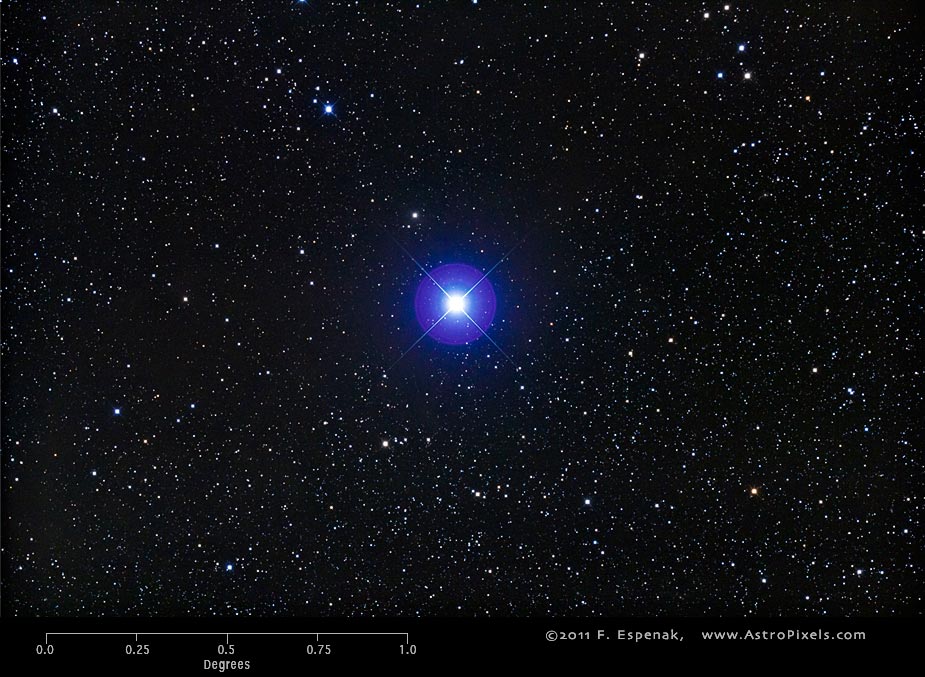Bellatrix
Bellatrix or Gamma Orionis (Gam Ori) is the 3rd brightest naked eye star in the constellation Orion. With an apparent magnitude of 1.64, Bellatrix is the 26th brightest star in the entire sky (see: 50 Brightest Stars ). Its absolute magnitude is -2.72 and its distance is 243 light years.The Equinox J2000 equatorial coordinates are RA = 05h 25m 07.9s, Dec = +06° 20' 59".
Bellatrix has a spectral type of B2III, a surface temperature of 21,500° Kelvin and a luminosity 4000 times the Sun. It has a mass of 8 solar masses and a diameter 5.7 times the Sun.
The image above shows the uncropped view of Bellatrix (North is up) through the Takahashi E-180 Astrograph.
Bellatrix is a massive blue-white star (spectral type B2 III) with an effective temperature of 22,000° K, making it considerably hotter than the Sun (5,778° K). With a mass 8.4 times the Sun's mass, it has an estimated age of approximately 20 million years. This long enough for a star of this mass to consume the hydrogen at its core and begin to evolve away from the main sequence into a giant star. The measured angular diameter of Gamma Orionis, after correction for limb darkening, is 0.72 milliarcseconds. At an estimated distance of 250 light years (77 parsecs), this yields a physical size of about 6 times the radius of the Sun.
Since 1963, Bellatrix was included with a set of bright stars that astronomers employ as a luminosity standard. These are used for comparison with other stars to check for variability, and so by definition, the apparent magnitude of Gamma Orionis was set to 1.64. However, when an all-sky photometry survey was carried out in 1988, this star was itself found to be variable. It ranges in apparent magnitude from 1.59 to 1.64.
Bellatrix was once thought to belong to the Orion OB1 Association of stars that share a common motion through space, along with the "Orion's Belt" stars(Alnitak, Alnilam and Mintaka). However, this no longer believed to be the case, as Gamma Orionis now known to be much closer than the rest of the group. It is not known to have any stellar companions. A 2011 search for nearby companions failed to conclusively find any objects that share a proper motion with Bellatrix. Three nearby candidates were all found to be background stars.
The description above is based on the Bellatrix entry in Wikipedia.For more information about Bellatrix, see Stars (Jim Kaler).
Technical Details
- Object: Bellatrix
- Other Names: Gamma Orionis, HR1790, HD35468, HIP25336
- Object Type: bright star
- Object Data: Apparent Magnitude = 1.64, Absolute Magnitude = -2.72, distance = 243 light years
- Object Position (Equinox J2000): RA = 05h 25m 07.9s, Dec = +06° 20' 59", Constellation = Orion
- Date/Time: 2011 Nov 02 at 11:31:08 UTC
- Location: Bifrost Astronomical Observatory, Portal, AZ
- Mount: Astro-Physics 1200GTO
- Telescope: Takahashi Epsilon 180 Hyperbolic Astrograph
- Camera: Canon EOS 550D (Rebel T2i) (modified with a Baader UV/IR filter)
- Field of View: 1.70° x 2.56° at 1.7 arc-sec/pixel (web version: 10.0 arc-sec/pixel)
- Exposure: 2 x 240s, f/2.8, ISO 800
- File Name: Bellatrix-01w.jpg
- Processing (Adobe Camera Raw): Graduated Filter, Vignetting Correction, Noise Reduction, White Balance, Curves
- Processing (Photoshop CS5): Average Images, Curves, Noise Reduction
- Original Image Size: 3454 × 5179 pixels (17.9 MP); 11.5" x 17.3" @ 300 dpi
- Rights: Copyright 2011 by Fred Espenak. All Rights Reserved. See: Image Licensing.
